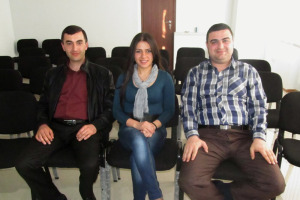
| 2014-03-27 05:55:04 |
Cosmic Ray Division Young Researchers Make International Impact
Three of the researchers from Cosmic Ray Division of Yerevan Physics Institute, Levon Vanyan, Tigran Karapetyan and Hripsime Mkrtchyan will participate in international meetings presenting and discussing CRD research results.
From 27th of April through 02 of May, in Vienna, Austria, Levon Vanyan will participate in the European Geosciences Union (EGU) General Assembly. AGU brings together scientists from all over the world to one forum to discuss new developments in all disciplines of the Earth, planetary and space sciences. Levon’s presentation is titled “The Origin of Thunderstorm Ground Enhancements (TGEs): Energy Spectra Analysis”.
Tigran Karapetyan will travel to Sozopol, Bulgaria to take part in the Solar Influences on the Magnetosphere, Ionosphere and Atmosphere conference to be held from May 26 to 30. Tigran will present a report on the significant enhancement of cosmic ray fluxes in our galaxy due to the enormous weakening of solar activity since 2006. This enhancement poses additional hazard to the satellite electronics.
Thunderstorm Effects on the Atmosphere-Ionosphere System (TEA-IS) summer school in Lyon, France, will start on June 23 and last until the 27th. The goal of the TEA-IS Summer School is to train to scientists, particularly young scientists, interested in better understand the role of thunderstorms in the atmosphere-ionosphere-magnetosphere system. The students will also have an opportunity to report on their own work in the field. CRD’s PhD student Hripsime Mkrtchyan will report on lightning detection networks operated in Armenia and their relation to Thunderstorm ground enhancements (TGE). TGEs are high-energy phenomenon in the atmosphere first discovered and characterized by Armenian physicists of the CRD. Recently a node of the Worldwide Lightning Location Network (WWLLN) was established in Yerevan to further explore this phenomenon. Hripsime is investigating correlations of WWLLN lightning detection with the same lightning detection by local Armenian network operated on slopes of Mt. Aragats.
All 3 of the young CRD scientists have received financial support from the conference organizers to assure their attendance, confirming the international appreciation for the work done at CRD in Armenia.
For its part in enhancing the cooperation between international scientist in this exciting new field, CRD in partnership with Skobeltsyn Institute of Nuclear Physics of Moscow State University, has established the series of symposiums calledThunderstorms and Elementary Particle Acceleration (TEPA). The first one in the series was held in Armenia in 2010 with the expectation of a biannual event rotating between participating countries. The second one was held in Moscow in 2012. The participants then decided that given the rapid knowledge gain in this field the TEPA conference series should become an annual event. TEPA 2013 was held in Armenia and TEPA 2014 is scheduled for September 22-26, 2014 again in Armenia at CRD’s Nor Amberd International Conference Centre of the Yerevan Physics Institute. Scientists from USA, Europe and Russia will gather to discuss the most intriguing problems of high-energy physics in the atmosphere and on possible directions for the advancement in research and collaborative studies. TEPA 2014 has received financial support from the European Geosciences Union to assist young scientists to participate this important symposium.

Figure 1. From left to right: Tigran Karapetyan, Hripsime Mkrtchyan, Levon Vanyan
